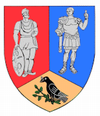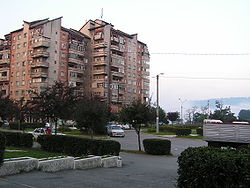- Petroșani
-
For the village in Constanţa County, see Deleni, Constanţa.
Petroşani — Municipality — Apartment building 
Coat of armsLocation of Petroşani Coordinates: 45°24′44″N 23°22′24″E / 45.41222°N 23.37333°ECoordinates: 45°24′44″N 23°22′24″E / 45.41222°N 23.37333°E Country  Romania
RomaniaCounty Hunedoara County Status Municipality Government – Mayor Tiberiu Iacob Ridzi (Democratic Party) Area – Total 195.56 km2 (75.5 sq mi) Population (2002) – Total 45,194 Time zone EET (UTC+2) – Summer (DST) EEST (UTC+3) Website http://www.petrosani.ro/ Petroşani (Romanian pronunciation: [petroˈʃanʲ]; German: Petroschen; Hungarian: Petrozsény) is a city in Hunedoara County, Romania, with a population of 45,447 (2002).
Contents
History
The city of Petroşani was founded in the 17th century (around 1640). In 1720, an Austrian cartographer mentions that the entire Jiu Valley was intensly populated and settlements could be seen from one end to the other.
During the 1818 census, Petroşani had 233 inhabitants, while the entire Valley counted 2550. During this time, the main activity of the people was shepherding and no urban settlement had appeared yet.
Around 1840 coal surface mining began in Petroşani, Vulcan and Petrila.
The population encountered a massive increase only in the 20th century during the communist regime, as many workers were brought in from other parts of the country.
Geography
Petroşani is located in the Jiu Valley, which is the entrance to the Retezat National Park and provides access to the Vâlcan, Parâng and Retezat mountains. The city administers four villages: Dâlja Mare, Dâlja Mică, Peştera and Slătinioara.
Landmarks
- Sfinţii Arhangeli Church ("Holy Archangels Church"), built in the 18th century.
- The "I. G. Duca" school, built in 1935
- The Hungarian school - built in 1873 by Germans and inhabited by a group of 50 Catholic nuns from a monastery near Munich
- The Old Theater, built in 1886
- The Lutheran Church, built between 1892 and 1896
- The Mining Museum, built in 1900
- The actual Sports School building, built in 1919
- The "I. D. Sîrbu" Theater Hall, built in 1905
- The Justice Court building, built in 1910
- The actual Students theater, built in 1922
- The Unitarian Church, built between 1924 and 1928
- The University of Petroşani, built in 1948
- The Jiul Shopping Center, re-opened in December 2007 after renovation, initially built in the early 1980s
Social events
The following social events take place in Petroşani:
- the Dramatic Theater offers a wide variety of performance every week
- the annual international folklore festival
- the Folk Music Festival Cântecul Adâncului... ("Song of the Deep")
- artistic summer camps organized by the Petroşani University
- art, numismatic and caricatures exhibitions
- piano and violin recitals, offered by the Music School
- the Petroşani Days festival, usually organized in autumn
- the annual Underground Valley Graffiti Fest
Demographics
At the 2002 census, 89.4% of inhabitants were Romanians, 8.4% Hungarians, 1.2% Roma and 0.6% Germans. 83.3% were Romanian Orthodox, 7.2% Roman Catholic, 3.7% Reformed, 2.2% Pentecostal, 0.9% belonged to another religion and 0.8% Greek-Catholic.
See also
External links
- Jiu Valley Portal - the regional portal host of the official Petrosani municipal website
Hunedoara County, Romania Cities 
Towns Communes Baia de Criş · Balşa · Băniţa · Baru · Băcia · Băiţa · Bătrâna · Beriu · Blăjeni · Boşorod · Brănişca · Bretea Română · Buceş · Bucureşci · Bulzeştii de Sus · Bunila · Burjuc · Cerbăl · Certeju de Sus · Cârjiţi · Crişcior · Densuş · Dobra · General Berthelot · Ghelari · Gurasada · Hărău · Ilia · Lăpugiu de Jos · Lelese · Lunca Cernii de Jos · Luncoiu de Jos · Mărtineşti · Orăştioara de Sus · Pestişu Mic · Pui · Rapoltu Mare · Răchitova · Ribiţa · Râu de Mori · Romos · Sarmizegetusa · Sălaşu de Sus · Sântămăria-Orlea · Şoimuş · Teliucu Inferior · Tomeşti · Topliţa · Toteşti · Turdaş · Vaţa de Jos · Vălişoara · Veţel · Vorţa · Zam
Categories:- Populated places in Hunedoara County
- Jiu Valley
- Cities in Romania
Wikimedia Foundation. 2010.


